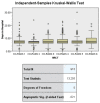Exploring the Relationship of Comorbidities, Smoking Status, HRCT Findings With COVID-19 Disease Severity and Outcomes
- PMID: 38406150
- PMCID: PMC10893976
- DOI: 10.7759/cureus.52937
Exploring the Relationship of Comorbidities, Smoking Status, HRCT Findings With COVID-19 Disease Severity and Outcomes
Abstract
Introduction: Coronavirus disease 2019 (COVID-19) is a serious illness that can affect multiple organs including the lungs. The COVID-mortality risk is attributed to the quick transmission of the virus, the severity of disease, and preclinical risk factors, such as the presence of comorbidities. High-resolution computed tomography (HRCT) can predict disease severity in COVID-19 patients.
Methodology: This was a retrospective cohort study in which data were obtained from COVID centers at tertiary care hospitals in Azad Jammu and Kashmir. Details of clinical characteristics and HRCT findings along with details of smoking and comorbid history were obtained.
Results: Fever at hospital admission, HRCT findings, and having a partner predicted disease severity showed a significant p-value of <0.05. Old age and living in a combined household were associated with severe outcomes (p<0.05). Symptoms of shortness of breath (SOB) on hospital admission could predict the need for ICU admission in COVID-19 patients.
Conclusion: HRCT has a good predictive value for disease severity in patients with COVID-19, and old age is a risk factor. Although, limited associations were established in the analysis, in this study hyperlipidemia and hypertension significantly affected the course of disease. Further studies should be done to explore the relationship.
Keywords: comorbid; covid-19 outcomes; disease severity; high resolution computed tomography; smoking.
Copyright © 2024, Khan Raja et al.
Conflict of interest statement
The authors have declared that no competing interests exist.
Figures


Similar articles
-
Clinico-Radiological Evaluation and Correlation of CT Chest Images with Progress of Disease in COVID-19 Patients.J Assoc Physicians India. 2020 Jul;68(7):34-42. J Assoc Physicians India. 2020. PMID: 32602679
-
Data from the first wave of Covid-19 from the Central Military Hospital, Prague, Czech Republic.Epidemiol Mikrobiol Imunol. 2020 Winter;69(4):164-171. Epidemiol Mikrobiol Imunol. 2020. PMID: 33445940 English.
-
Presenting Characteristics, Comorbidities, and Outcomes Among Patients With COVID-19 Hospitalized in Pakistan: Retrospective Observational Study.JMIR Public Health Surveill. 2021 Dec 14;7(12):e32203. doi: 10.2196/32203. JMIR Public Health Surveill. 2021. PMID: 34710053 Free PMC article.
-
Convalescent plasma or hyperimmune immunoglobulin for people with COVID-19: a rapid review.Cochrane Database Syst Rev. 2020 May 14;5(5):CD013600. doi: 10.1002/14651858.CD013600. Cochrane Database Syst Rev. 2020. Update in: Cochrane Database Syst Rev. 2020 Jul 10;7:CD013600. doi: 10.1002/14651858.CD013600.pub2. PMID: 32406927 Free PMC article. Updated.
-
Meta-analysis investigating the relationship between clinical features, outcomes, and severity of severe acute respiratory syndrome coronavirus 2 (SARS-CoV-2) pneumonia.Am J Infect Control. 2021 Jan;49(1):82-89. doi: 10.1016/j.ajic.2020.06.008. Epub 2020 Jun 12. Am J Infect Control. 2021. PMID: 32540370 Free PMC article. Review.
Cited by
-
Predictors of 2-year mortality in geriatric patients hospitalized with COVID-19 in Türkiye: a retrospective cohort study.Biomark Med. 2024;18(10-12):555-565. doi: 10.1080/17520363.2024.2352416. Epub 2024 Aug 14. Biomark Med. 2024. PMID: 39140394 Free PMC article.
References
-
- Clinical characteristics and risk factors for mortality in patients with coronavirus disease 2019 in intensive care unit: a single-center, retrospective, observational study in China. Sai F, Liu X, Li L, et al. Ann Palliat Med. 2021;10:2859–2868. - PubMed
LinkOut - more resources
Full Text Sources
